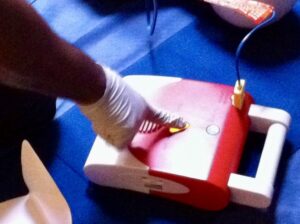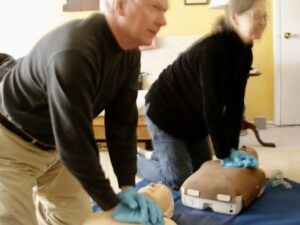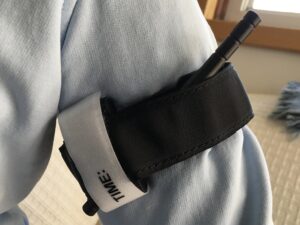Need help in deciding which class is best for you?
There are many classes listed here from which to choose. While they are all excellent, there are differences, so please read these class descriptions carefully.
Looking for training and certification for your employment or school? If so, it’s best to ask them which class they require for you. If they don’t know the answer to that question, you can always refer them to this class descriptions page.
In the end, however, it is the student’s responsibility to make the correct determination before registering for a class. Thus, if still unclear about what class to choose, please contact us and we’ll do our best to assist you.
Note: “Infant CPR/AED” teaches how to provide care for someone from birth up to age one. “Child CPR/AED” teaches how to provide care for someone from age one up to age 12 (or, approximately, the first signs of puberty). “Pediatric CPR/AED” teaches a combination of both Child and Infant CPR/AED skills. And “Adult CPR/AED” teaches how to provide care for someone above age 12.
CPR/AED certification for the general public

Adult CPR/AED, Child CPR/AED, Infant CPR/AED (or any combination)
- safely check for signs of life;
- perform one-rescuer CPR;
- operate an automated external defibrillator (AED);
- use personal protective equipment (PPE), such as breathing barriers and gloves;
- assist choking victims.
You will also learn about the Good Samaritan Law and how it protects you when providing care in an emergency.
CPR-Twin Cities certification, awarded upon successful completion of this class, is valid for two years.

First Aid certification for the general public
First Aid (standard and pediatric)
In this course, you will learn how to:
- care for wounds (bleeding, burns, concussions and spinal injuries), including bandaging a wound and applying a sling;
- care for sudden illnesses (strokes, seizures, poisonings, diabetic reactions, allergic reactions, and heat- and cold-related emergencies).
You will also learn about the Good Samaritan Law and how it protects you when providing care in an emergency.
CPR-Twin Cities certification, awarded upon successful completion of this class, is valid for two years.
Combination CPR/AED and First Aid certification for the general public
First Aid plus Adult CPR/AED, Child CPR/AED, Infant CPR/AED
In this combination First Aid/CPR/AED class, you will meet the State of Minnesota requirements set forth in Rule 3 for child care workers. See above for descriptions of CPR/AED and First Aid for the general public.
CPR-Twin Cities certification, awarded upon successful completion of this class, is valid for two years.
AED certification for the general public

AED Training
Without rapid defibrillation, a victim’s chance of survival decreases by about 10 percent per minute. Using safe training devices, you will learn how to properly operate an automated external defibrillator. AED training classes are available for groups, held in the convenience of your workplace, practically anywhere in the Twin Cities (Minneapolis-St. Paul) area.
You will also learn about the Good Samaritan Law and how it protects you when providing care in an emergency.
CPR-Twin Cities certification, valid for two years, is available upon request.
Note: This class requires that you are currently certified in CPR-Twin Cities, American Red Cross or American Heart Association CPR.
Hands-Only CPR or Compression-Only CPR

CPR Without Breaths
This class teaches a simple, abbreviated version of CPR that provides continuous chest compressions — without any mouth-to-mouth or mouth-to-mask contact — for an adult victim of sudden cardiac arrest. In addition to providing hands-on practice with a manikin, the class also covers:
- the basics of how to recognize a medical emergency;
- how to protect yourself from disease transmission while giving first aid care;
- simple and safe things you can do until more advanced help arrives.
You will also learn about the Good Samaritan Law and how it protects you when providing care in an emergency.
Caring for Medical Emergencies (lecture)

What Non-Professionals Can Do to Help, Until Medical Help Arrives
This in-service is informal and can be customized to fit your group’s needs. In general, you will learn:
- how to recognize an emergency;
- how to help a victim until qualified help arrives.
You will also learn about the Good Samaritan Law and how it protects you when providing care in an emergency.
Note: Since this option is customizable, and follows no established curriculum, and because there is little, if any, hands-on practice, there is no certification.
Emergency Care for Severe Bleeding

Stop Life-Threatening Bleeding
While most bleeding is not life-threatening, some of it is. This class covers the basics of how to recognize a medical emergency and what to do until help arrives. We will discuss the Good Samaritan Law, as well as how to protect yourself from disease transmission while giving first aid care.
In this class, you will learn what you can do to help control bleeding (or, “stop the bleed,” as it’s often called). We will practice using nitrile (non-latex) gloves, including how to take them off properly, without contaminating yourself. Going beyond the simple bandaging taught in First Aid classes, we will also practice applying a tourniquet and packing a wound (using hemostatic dressing) to stop the bleed.
BLS CPR/AED certification for health & safety pros
Basic Life Support for Healthcare Providers
Note: Sorry, we are not currently offering this class.
In this class for health and safety professionals (nurse, paramedic, EMT, first responder, lifeguard, etc.), you will learn all of the skills of one-rescuer Adult and Pediatric CPR classes. Plus you will learn how to provide two-rescuer CPR, how to operate an automated external defibrillator (AED), how to use a bag-valve-mask (BVM), how to use personal protective equipment (such as breathing barriers and gloves), and how to assist choking victims. You will also learn about the legal considerations regarding providing care.
You will also learn about the Good Samaritan Law and how it protects you when providing care in an emergency (when not expecting/accepting compensation for providing care).
CPR-Twin Cities certification, awarded upon successful completion of this class, is valid for two years. This certification is the equivalent of the American Red Cross class, “Basic Life Support for Healthcare Providers” and the American Heart Association class, “BLS for Healthcare Providers.”
Note: To take a recertification class, you must have successfully completed this CPR-Twin Cities class (or its American Red Cross or American Heart Association equivalent) within the past two years (with a one-month grace period). If you don’t qualify, please sign up for an initial certification class instead.
Note: There are no prerequisites for taking this class and you don’t even need to be a health and safety professional. All you need is a desire to learn more than in a CPR class for the general public.
